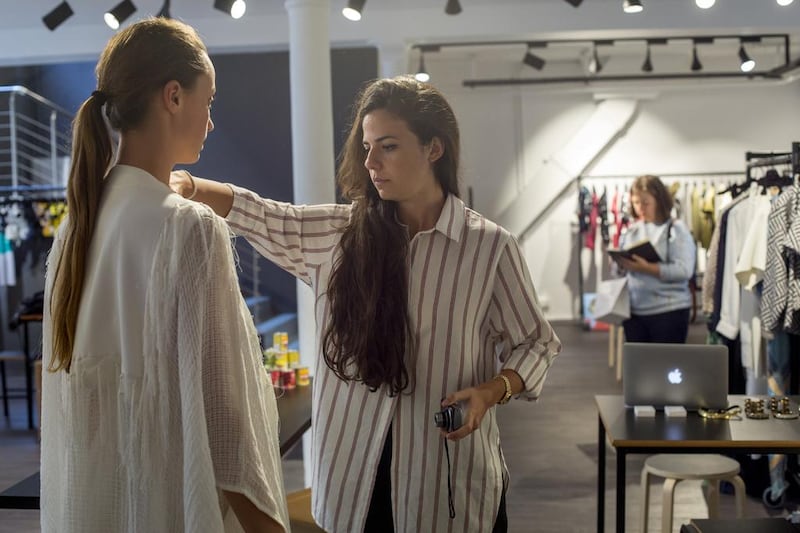In a showroom set back from a seedy street in the Marais neighbourhood, the hidden Paris Fashion Week is taking place.
No, this isn’t some hip underground show by an emerging designer. There are no street-style mavens, hysterical bloggers or hard-nosed photographers encircling the entrance. Instead, rails of brightly coloured clothing line the white-painted wall, while in the centre, long tables are weighed down with laptops, folders and paperwork, pored over by studious women.
This is the real fashion week, away from the media circus. While the celebrities pose in the front rows, the nitty-gritty work of taking clothes from sample to shop is pursued by designers, boutique owners, sales people and the all-important fashion buyers.
Flicking swiftly through the rails at Stella Jean (the Vogue Italia editor Franca Sozzani’s current favourite) is Farah Mounzer, the buying manager at The Dubai Mall boutique Symphony. She’s here with Salama Alabbar, the owner and driving force behind the store’s success, to pick out the pieces that will be stocked in Dubai in spring/summer 2015. This is one of many appointments around Paris this week, with brands ranging from the famous (such as Temperley London) to the barely launched.
There are no catwalk shows for these two – but they don’t mind: with six or seven appointments a day, this is far more efficient.
“You see the fabrics and the fit up-close, there are more brands – there’s so much more in the showroom than you see in a fashion show,” says Alabbar.
We’ve just walked here at a frenetic pace from the previous appointment in another part of Paris, because taking a taxi in the city’s traffic is simply too slow when you have this many brands to see and when each appointment could take anywhere from 45 minutes to four hours.
Earlier, Mounzer and Alabbar spent several hours at the Paper Mache Tiger showroom – which hosts two floors of brands that display their wares for international buyers – hitting appointments that had been planned weeks earlier with military precision.
These are just the sort of brands Symphony is made for: well-known enough to have earned insiders’ respect but obscure enough to please those shoppers who search beyond the behemoths of fashion. I join the pair as they sit down with two brands, the Swedish company Rodebjer and the New York-based Araks.
This isn’t just about finding clothes they like, says Alabbar. It’s also about practicality. “We’re thinking of what we’ve sold before, what works, what doesn’t work, what works for certain sizes or certain occasions – is it for travel, for Ramadan, for Friday nights? We might see a coat we like, but it’s too thick and they won’t wear it in Dubai.”
Add to that the possibility of customising pieces to add sleeves, change the colours or lengthen the hemlines, together with the complexity of allocating budget to the different “drops” (the two seasonal deliveries that most brands make – for spring, the collections arrive in January and in March) – and you can see why Mounzer needs to be, as she says, “very good with numbers”.
This process is brutal to watch. Anyone who thinks being a fashion buyer is like going on a shopping spree with someone else’s credit card should think of the insouciantly stylish Mounzer, who’s deliberately inscrutable though always polite, shaking her head at piece after piece by Rodebjer. She’s no gushing fashionista.
“I’m very black-and-white, very organised, very on time,” she says. “I don’t like to be delayed. I have my deadlines and I know the brands have their deadlines, so I get back to them promptly, I don’t go to shows; I just have dinner and that’s it. Back home, when I’m resting, I’ll have my personal opinion about what’s pretty, but when I’m buying I only think of the customer. This is one of the main reasons I don’t do shows – I don’t like to be emotionally attached to the collection. I just go as if I’m buying books and pens.”
There’s certainly no time for niceties, as across the room the designer and sales manager at Araks are waiting for their turn to impress the Symphony girls. Yet, over the course of the hour, a selection of beautiful Rodebjer dresses, trousers, jackets and tops accumulates on the rail.
Two models take it in turns to show off items picked by the sales manager, Holly McNally, and by Mounzer and Alabbar, and they look so very different off the hanger. Some win, some lose – a moment of inspiration sees McNally sling a long, graphic cardigan over a silken pyjama set and it’s an instant hit – but many of the pieces that one would think were almost made for Dubai, such as long silky shirts and fluid dresses, don’t make the cut.
“We try not to be too commercial,” says Alabbar. “A lot of the time, salespeople will recommend a piece saying: ‘This is commercial.’ But we try to avoid the obvious pieces.”
Afterwards, the rail is assessed, items rearranged, added and removed to create the perfect mix, before the serious work begins: the spreadsheets that will balance the budget on Mounzer’s computer and the order lists on McNally’s. By the time you see this collection in the boutique, in six months’ time, it will include a multitude of other designers. Then the pressure’s really on, as the brand will have to impress Dubai’s fashionistas as much as it impressed the Symphony girls.
artslife@thenational.ae





